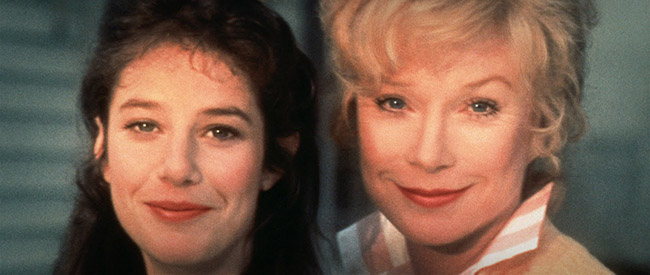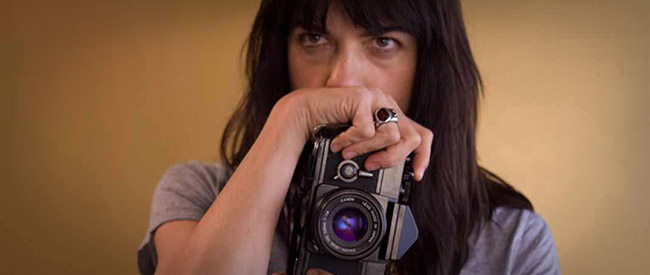Old v. New: The Parent-Child Relationship in ‘Terms of Endearment’ and ‘Mothers and Daughters’
In our regular feature Old v. New, Kimberly Marcela Duron compares a newer independent release with an older classic to see what similarities they share, how they diverge and hear what the conversation between the two films says about filmmaking as the art form continues to innovate and evolve.
***
In honor of Mother’s Day this past Sunday, what better way for a film lover to celebrate his or her mom than by either A) reminiscing with a classic mother-child themed Hollywood classic, or B) catching up with a newer mom-centric indie?
James L. Brooks’ 1983 drama Terms of Endearment and Paul Duddridge’s recently released Mothers and Daughters are two possible picks for the occasion. Both films have deceptively simple plot lines, providing a glimpse into the life of one specific mother and daughter relationship over time. But if the stories are simple, its because the relationships at hand are complex enough—these films are, essentially, character studies conducted by two very different filmmakers, each using the tools they love.
Similar to other successful ‘80s films like Rain Man and On Golden Pond—each of which dealt with strained family dynamics—Terms of Endearment explores the relationship between an overbearing, Type-A mom (Shirley MacLaine) and her seemingly carefree daughter (Debra Winger). The first few scenes of the film are crucial in setting up and defining each character’s personality. In the film’s prologue, Shirley MacLaine’s Aurora believes that her newborn daughter is dead just because she hasn’t cried—so Aurora unapologetically nudges the baby until it wakes up and, naturally, begins to wail.
This single scene sets up Aurora and her daughter Emma’s (played as an adult by Winger) relationship as a constant one-way need for reassurance on Aurora’s behalf—not a reassurance of understanding or even love, but rather the affirmation that her daughter is simply there and doing well. By contrast, Emma seems to forgive her mother too quickly for not attending her straight-out-of-high-school wedding. This becomes a recurring theme: the two disagree on Emma’s choices and appear to fight when, in reality, Aurora always just wants what’s best for her daughter—while Emma just wants what’s best for her family.

Fast-forward a couple decades to a time where interwoven or multi-narrative films like Crash, Love Actually and New York, I Love You have practically become their own cinematic genre, rather than a screenwriting technique. Paul Duddridge’s Mothers and Daughters is a multi-narrative of sorts, telling the disparate stories of four mothers—played by Courtney Cox, Susan Sarandon, Sharon Stone and Mira Sorvino—whose relationships with their daughters are all on the rocks for one reason or another.
Mothers and Daughters approaches the study of tumultuous parent-child relationships within the context of modern communication. All four mothers communicate with their daughters via Skype, emails or text messages more often than they do face to face. This seems to be the director’s attempt to capture the present zeitgeist, where devices have facilitated virtual contact, but have quite possibly limited actual (and invaluable) human interaction. For instance, one character—an adoptee—emails her biological mother to request some medical information, and signs off her communication with a request for continued anonymity, for the time being.
In another scene, when Christina Ricci’s character discovers that her “mom” was actually her grandmother, and that the person she believed was her older sister is her real mother, she refuses to answer any calls or texts from her newly-outed sibling-parent, imposing technological distance so she can cope with this major plot twist within her own life.
Many films have utilized these second-screens as storytellers in more chilling genres, like last year’s Skype thriller Unfriended. But in a “harmless” drama about relationships like Mothers and Daughters, perhaps the scariest thing idea that maybe one day parents will interact with their children solely video screens.

In Terms of Endearment, a much more literal form of distance plays a key factor as Emma moves to Iowa for the majority of the film. But even during this time, her communication with her mother never feels that remote. In an awkward comedic moment, Emma’s lover professes his feelings over the phone while Emma’s son pees in the toilet next to her. An operator interrupts them with an emergency call from Aurora. To this, Emma nonchalantly reassures the boyfriend that Aurora places “emergency” calls all time—namely, whenever Emma’s line is busy.
The two films vary tremendously in cinematography and writing style—not a surprise given the 33-year difference in technology. But both Shirley MacLaine and her maternal counterparts in Duddridge’s recent indie capture, on different levels, the heaviness of the struggles each film’s characters have endured for the sake of their kids, and both films capture the timeless nature of mothers, who—more often than not—must make difficult and inexplicable choices for the sake of their offspring.
That’s quite possibly the most relatable aspect of either film: the difficult, yet comforting, relationship between mothers and their children, whether these relationships are marked by death, disagreement, adoption or unplanned pregnancies. Motherhood and its unconditional, weirdly intuitive love has been a source of inspiration for filmmakers since the silent days, and will continue long after virtual reality becomes a thing of the past.
To learn more about Film Independent, subscribe to our YouTube channel. You can catch up with the rest of our blog here. And to learn how to become of Member of Film Independent, just click here.